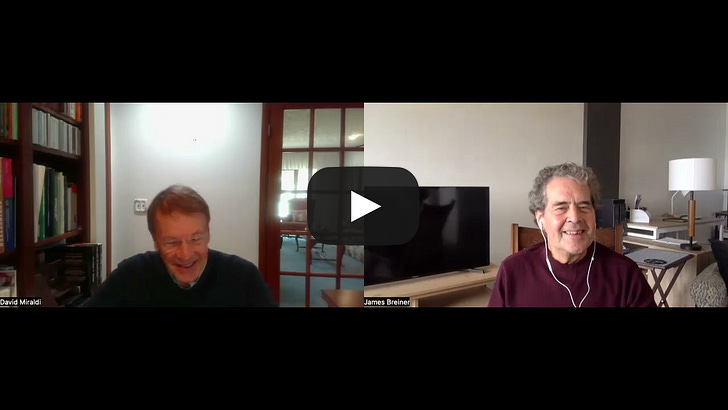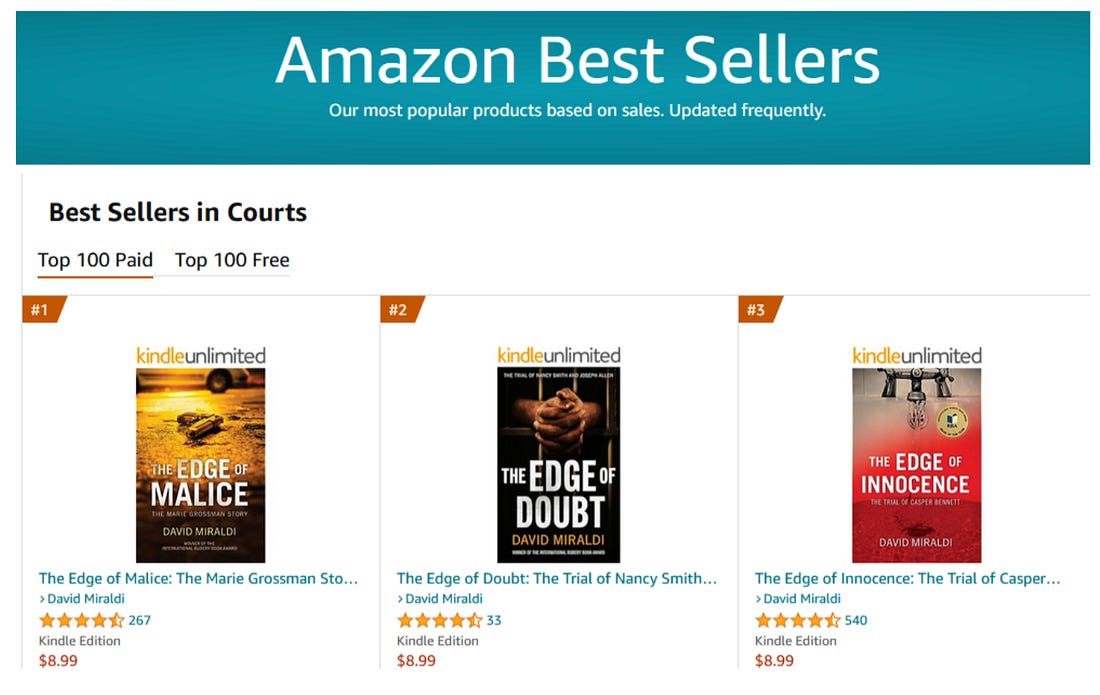You’re reading the My News Biz newsletter, which I will be sending you every other Thursday. My goal is to help you and other digital media entrepreneurs to find a viable business model that works for you. If you were forwarded this email, you can sign up here. How to get your book published, Part 3After three books about true crime, this lawyer is trying his hand at fiction (it's harder)You’re reading the Your News Biz newsletter. My goal is to help digital media entrepreneurs find viable business models. This is the third in our series on How to Get Your Book Published. The next two are based on experiences of David Miraldi, a lawyer turned true-crime writer. I have merged elements of a Zoom interview with his email update on his latest book — a novel. My friend David Miraldi was a courtroom attorney for decades, and he has published three books based on cases from his research and personal experience. Those three books fall into a genre described as “narrative nonfiction.” Possibly the most famous work in this category was Truman Capote’s “In Cold Blood.” Similar to Capote’s, Miraldi’s nonfiction books included dialogue and dramatic scenes he did not witness firsthand.
Getting a book published “is a tough business to crack,” Miraldi told me in an interview via Zoom. “You have two ways to do it. One is to be an independent writer and self publish. The other is to interest an agent in your book and have them promote you and be your gateway to publishers. “I began by self publishing. I learned to do things on my own.” That included marketing, finding an editor, and hiring a designer for the cover. His first book, “The Edge of Innocence,” published in 2017, was based on a murder case from the 1960s in which his father represented the accused. That book won Book of the Year from the International Rubery Awards for independent and self-published authors. “After my first book won the Rubery Award, I was able to get an agent and sell my next book, ‘The Edge of Malice.,’ to Prometheus Books, who were later acquired by Rowman & Littlefield.” The pandemic intervenes“My experience with the publisher was not what I had expected. I thought that they would obtain reviews for my book, market it extensively, and allow me to control the book's title and other production decisions. “Unfortunately, my book was released in April of 2020 in the midst of the pandemic when the publisher's entire marketing department had been furloughed. My wife and I did extensive marketing on our own. We also fought with the publisher regarding the title and the front cover, winning one battle and losing the other. “I was very dissatisfied with the arrangement. Although the publisher had an option on my next book, I asked them not to exercise it, and they did not. My wife and I eventually bought back the rights to the second book, ‘The Edge of Malice.’ We changed the cover and marketed it with my other books. It has done much better under our direction.”
Tough transition: from true crime to a novel“When writing narrative nonfiction, I first become immersed in research. I make sure I get the facts right, understand the players, and appreciate the dynamics between the characters. When I begin to write, I use some imagination and creativity to bring the story to life. “However, I am not inventing the story. I do not have to convince the reader that this really happened, because it did. My job is to make the story understandable (sometimes not easy with legal issues), entertaining, and embedded with a message that I want to communicate either directly or subliminally. “My first attempt at fiction came after I had written two narrative nonfiction books that had achieved modest success. I naïvely believed that I could easily make the transition. In retrospect, I was overconfident.” His wife hated it“Although my fictional story had some relation to an actual case, it was not that case. I wrote it as if I were still writing nonfiction. I also tried to do too much, interweaving two stories that I realize now resulted in a contrived plot. As I was writing the book, I also was not sure how I would end it — who would win the legal battle that was at the heart of the book. “My wife, also a lawyer, hated the book. To her, many of the scenes and dialogues did not feel real. My editors were kinder, telling me that this was not my best work. All three provided criticism that, although difficult to accept at the time, would later prove to be helpful. One editor suggested that I leave the book, return to narrative nonfiction, and come back to fiction later. Starting from scratch“I followed that advice and wrote another narrative nonfiction story involving a wrongful conviction. After a three-year break, I returned to the fiction. This time, unlike my earlier attempt, I carefully plotted the book using Aristotle’s Incline: three acts, mid-point plot point etc. “I also realized that every action had to have a purpose. Instead of trying to revise the earlier draft, I started over completely. I would use many of the same characters but this would be a new book. I started the book with a different opening scene and wrote a new ending before I wrote the meat of the book. “Unlike nonfiction, where the author can describe things with a few brush strokes, the writer of fiction must take care to create the world realistically and in greater detail without boring the reader. This applies to dialogues as well as actions. Everything has to feel real or the reader will abandon your book. Every scene must have some bearing on driving the ultimate story.” Brutal honesty“When I handed the new manuscript to my wife, she told me she would be brutally honest with me if she did not like it. She refused to discuss it with me as she read it—not one clue as to her thoughts. Finally, when she finished it, she silently handed it to me, but she, like an elementary school teacher, drew a big star on the front page. She liked it. My editor had a similar reaction. “At this point, I do not know how the book will be received. All I can say is that I know it is much better. It feels real and I hope it will keep the reader turning the page. It’s called ‘The Edge of Guilt,’ and I am hoping for a release at the end of May.” Below is my 2023 interview with David Miraldi, with subtitles. — James Breiner  Next week: How an author gets paid, and how much.+++ Previously: Invite your friends and earn rewardsIf you enjoy Your News Biz, share it with your friends and earn rewards when they subscribe. |
EL PERIÓDICO DE LOS PERIÓDICOS. SOMOS NOTICIAS. Para publicar, contactar: aliazon.comercialyventas@gmail.com
Páginas
- Inicio
- NACIONAL ESPAÑA
- INTERNACIONAL
- BOLETINES DIARIOS
- PORTADAS
- SOCIEDAD
- POLÍTICA
- SECCIONES
- ARTÍCULOS
- ECONOMÍA
- CULTURA
- NOTICIAS TURISMO
- PERIODISTAS
- REVISTAS
- NOTICIERO
- HEMEROTECAS
- REDES SOCIALES
- EVENTOS
- CLIMA
- PUBLICIDAD
- MENÚ
- COMUNICADOS DE PRENSA
- BOLETINES INFORMATIVOS
- MUNDO RURAL
- FEMINISMO
- GASTRONOMÍA
- EMPRESAS
- EL TIEMPO
- RADIO Y TELEVISIÓN
- CIENCIA
- MOTOR
- CONSUMO
- EDUCACIÓN
- TOROS
- OPINIÓN
- BLOGS
- ELECCIONES
- PODCASTS
- PASATIEMPOS
- NEWSLETTERS
- EMPLEO
- SERVICIOS
- SALUD
- ARTE
- BELLEZA
- LIBROS
- NEGOCIOS
- MEDIO AMBIENTE
- TECNOLOGÍA
- LOTERÍAS Y JUEGOS
- MODA
- OTROS
- HORÓSCOPO
- LIFESTYLE
jueves, 3 de abril de 2025
How to get your book published, Part 3
Suscribirse a:
Enviar comentarios (Atom)
ARTÍCULOS
¿Tienes información sobre alguna noticia interesante? aliazon.comercialyventas@gmail.com
ROPA Y COMPLEMENTOS ALIAZON
ROPA Y COMPLEMENTOS
OPINIÓN

Opinión y análisis // Diariocrítico.com
Artículos de Opinión | El Independiente
RSS de noticias de opinion
OPINION EL CONFIDENCIAL
Estrella Digital :: Últimas opiniones
Nuevatribuna :: Últimas opiniones
OPINIÓN-KHAMENEI
ÚLTIMAS NOTICIAS

ÚLTIMAS NOTICIAS
Últimas noticias // Diariocrítico.com
Estrella Digital :: Últimas noticias
Comentarios en: Últimas noticias
RSS de noticias de ultima-hora
PORTADAS
RSS de noticias de portada
NACIONAL ESPAÑA

Noticias nacionales | Diariocritico // Diariocrítico.com
MUNDO-KHAMENEI
CULTURA
ARTE
Arte y Cultura // Diariocrítico.com
TEATRO
Salud y vida saludable // Diariocrítico.com
SEXUALIDAD
Sexualidad y salud sexual y para disfrutar de las relaciones en pareja // Diariocrítico.com
SALUD
HISTORIA
Canal Historia // Diariocrítico.com
TURISMO
SOCIEDAD

Sociedad EL CONFIDENCIAL
LIFESTYLE
Estilo Hombre
MODA
CRÓNICA ROSA
Noticias del Corazón // Diariocrítico.com
LO MÁS LEÍDO
Lo más leido de la semana // Diariocrítico.com
CIENCIA
LIBROS
Noticias de libros, editoriales, autores y premios literarios // Diariocrítico.com
ECONOMÍA

Economía-EL CONFIDENCIAL
La actualidad económica en vivo - France 24
RSS de noticias de economia
COMENTARIOS DE ECONOMÍA
Comentarios de la Economía // Diariocrítico.com
Noticias economicas | Diariocritico // Diariocrítico.com
MERCADOS

Mercados - EL CONFIDENCIAL
EMPRESAS

Empresas - EL CONFIDENCIAL
FINANZAS







No hay comentarios:
Publicar un comentario